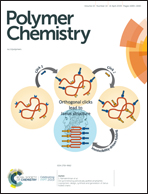Sustainable and rapidly degradable poly(butylene carbonate-co-cyclohexanedicarboxylate): influence of composition on its crystallization, mechanical and barrier properties†
Abstract
Aliphatic polycarbonates are an attractive research subject in the field of degradable materials. However, their relatively poor thermal properties limit their application. Here, poly(butylene carbonate) (PBC) was modified with 1,4-cyclohexanedicarboxylic acid (CHDA), a biomass-derived aliphatic ring monomer. Thermal degradation of short butylene carbonate segments was effectively avoided by one-step melt polycondensation of the oligomers. All the PBCCEs were random copolymers, and the trans content of CHDA in all cases was no less than 90%; this ensured the crystallizability of the butylene cyclohexanedicarboxylate (BCE) units. The glass transition temperature, melting temperature and thermal stability increased with the number of BCE units. The PBCCEs were semi-crystalline after thermal equilibrium was reached, and PBCCE50 to PBCCE90 contained PBCE crystals while PBCCE20 possessed XRD diffraction peaks similar to those of PBC. Small-angle X-ray scattering suggested that the randomly oriented lamellar structure of the PBCCEs became more ordered as the number of BCE units increased. PBCCE70-PBCE revealed a t1/2 of less than 30 s, indicating the rapid crystallization rate of the BCE units. The mechanical properties were closely related to the crystallization ability, and PBCCE50 to PBCCE90 showed good elastic moduli (87 to 520 MPa), high tensile strengths (22.8 to 39.5 MPa) and large elongations at break (930% to 413%). The gas barrier properties gradually increased with the number of BCE units, showing results several times higher than those of commercial poly(butylene adipate-co-terephthalate) (PBAT). Moreover, the addition of aliphatic rings slightly weakened the biodegradability, and obvious weight loss could be observed for PBCCE70. This result was higher than those of most aliphatic-aromatic copolyesters, which are degradable when their aromatic diacid content is less than 60%. PBCCE50 displayed a weight loss greater than 90% after 30 days, which is much faster than that of PBC. The results of this study indicate that PBCCE copolyesters exhibit great potential for applications in the plastics industry, such as green packaging and tissue engineering.



 Please wait while we load your content...
Please wait while we load your content...